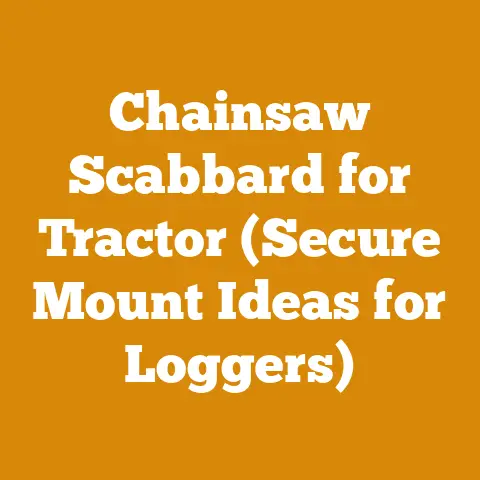How to Calculate Board Feet in a Log (5 Expert Tips)
Ever stood staring at a felled log, envisioning beautiful furniture, sturdy framing, or a winter’s worth of cozy fires, only to be stumped by the question: “How much wood is actually in there?” I know I have. I remember the first time I tried to estimate the board feet in a massive oak log on my property. I eyeballed it, guessed wildly, and ended up severely underestimating the yield. Let’s just say my initial project budget was… optimistic.
Calculating board feet in a log isn’t just an academic exercise; it’s crucial for budgeting any woodworking, logging, or firewood project. Underestimate, and you’ll face unexpected expenses and material shortages. Overestimate, and you might tie up capital unnecessarily. It’s a skill that separates the seasoned woodworker from the weekend warrior.
In this article, I’ll share five expert tips to help you accurately calculate board feet in a log, along with crucial cost considerations to keep your project on track and your wallet happy. We’ll delve into the formulas, explore practical tools, and discuss the real-world factors that can influence your final lumber yield and, consequently, your budget. Let’s get started!
Understanding Board Feet: The Language of Lumber
Before diving into the calculations, let’s define what we’re measuring. A board foot is a unit of volume for lumber, representing a piece of wood 1 inch thick, 12 inches wide, and 12 inches long. Think of it as a standard building block in the lumber world.
- 1 board foot = 1 inch (thickness) x 12 inches (width) x 12 inches (length)
This standard unit allows for consistent pricing and measurement across different wood species and dimensions. However, understanding board feet is just the first step. The real challenge lies in accurately estimating the board foot content of a raw log.
Tip #1: Mastering the Doyle Log Rule: A Logger’s Classic
The Doyle Log Rule is the most widely used formula for estimating board feet in a log, especially in North America. It’s an older rule, known for its simplicity, but also for its tendency to underestimate the actual yield, particularly for smaller logs. It can be calculated as follows:
- Board Feet = (Small End Diameter in Inches – 4)² x (Log Length in Feet) / 16
Example:
Let’s say you have a log that’s 16 feet long with a small end diameter of 12 inches.
- Board Feet = (12 – 4)² x (16) / 16
- Board Feet = (8)² x (16) / 16
- Board Feet = 64 x 1
- Board Feet = 64
According to the Doyle Log Rule, this log contains approximately 64 board feet.
Why It Matters for Your Budget:
While easy to use, the Doyle rule’s underestimation means you might need to purchase more logs than initially planned to meet your project requirements. This directly impacts your material costs.
Cost Consideration: Timber Purchase Costs
The price of logs varies significantly depending on species, grade (quality), and location. Hardwoods like oak, maple, and cherry command higher prices than softwoods like pine or fir. Expect to pay anywhere from \$0.50 to \$5.00 per board foot for standing timber, depending on these factors. This price will be affected by the logging crew’s fees if you are not felling trees yourself.
I remember once purchasing a load of mixed hardwoods based on the Doyle rule estimate. I was pleasantly surprised when the mill yielded more lumber than expected, but it’s generally safer to budget for a potential shortfall.
Tip #2: The Scribner Log Rule: A More Conservative Approach
The Scribner Log Rule is another common method for estimating board feet, often favored for its more conservative estimates, especially for larger logs. This rule uses a diagram-based approach to account for the waste incurred during sawing. While the actual calculation is complex, tables based on the Scribner Log Rule are readily available online and in forestry handbooks.
How to Use a Scribner Log Rule Table:
- Measure the small end diameter of the log in inches.
- Measure the length of the log in feet.
- Consult a Scribner Log Rule table to find the corresponding board foot estimate.
Example:
Using a Scribner Log Rule table, a log with a 16-foot length and a 12-inch small end diameter might yield approximately 70 board feet.
Why It Matters for Your Budget:
The Scribner rule’s tendency to provide higher estimates can help you avoid under-budgeting, but it can also lead to overestimating your lumber needs and potentially overspending on raw materials.
Cost Consideration: Logging and Transportation Costs
Felling a tree and getting it to a mill or your workshop involves labor, equipment, and transportation. Hiring a professional logging crew can cost anywhere from \$500 to \$2,000 per day, depending on the size of the crew, the complexity of the job, and the equipment used. Transportation costs can range from \$2 to \$5 per mile per load, depending on the distance and the size of the truck.
I once tried to save money by felling and transporting logs myself using my pickup truck. It was a backbreaking experience, and I ended up damaging my truck bed. Lesson learned: sometimes, hiring professionals is worth the investment.
Tip #3: The International 1/4-inch Log Rule: The Most Accurate (and Complex)
The International 1/4-inch Log Rule is generally considered the most accurate of the three common log rules. It accounts for a 1/4-inch kerf (saw blade thickness) for each saw cut and assumes a specific tapering of the log. This rule is more complex to calculate manually, but it provides the most realistic estimate of usable lumber.
Formula (Simplified):
The International 1/4-inch Log Rule involves a series of calculations based on log diameter, length, and taper. For practical use, it’s best to rely on pre-calculated tables or specialized software.
Example:
Using an International 1/4-inch Log Rule table, a log with a 16-foot length and a 12-inch small end diameter might yield approximately 80 board feet.
Why It Matters for Your Budget:
While more complex, the International 1/4-inch Log Rule provides the most accurate estimate, minimizing the risk of both under- and over-budgeting. However, the added complexity might require specialized tools or expert consultation.
Cost Consideration: Milling Costs
Turning a log into usable lumber requires milling. Hiring a portable sawmill operator can cost anywhere from \$75 to \$150 per hour, or \$0.25 to \$0.50 per board foot. The cost depends on the type of mill, the complexity of the cuts, and the operator’s experience.
I’ve used both portable sawmills and large-scale commercial mills. Portable sawmills offer flexibility and on-site processing, but commercial mills often provide better precision and higher throughput, especially for large projects.
Tip #4: Embrace Technology: Log Scaling Apps and Calculators
In today’s digital age, there’s no need to rely solely on manual calculations or printed tables. Numerous log scaling apps and online calculators are available to streamline the process. These tools allow you to input log dimensions and automatically calculate board feet using different log rules.
Popular Log Scaling Apps:
- Log Calculator: (Available on iOS and Android) – Offers multiple log rules and easy data input.
- Timber Volume Calculator: (Available on Android) – Provides detailed volume calculations and supports various measurement units.
- Board Foot Calculator: (Online) – A simple web-based tool for quick calculations.
Benefits of Using Technology:
- Accuracy: Reduces the risk of human error.
- Efficiency: Speeds up the calculation process.
- Convenience: Allows for on-the-spot estimations in the field.
Cost Consideration: Tool Maintenance and Replacement
Whether you’re using a chainsaw, a log splitter, or a wood chipper, regular maintenance is crucial to keep your equipment running smoothly and prevent costly breakdowns. Budget for oil, filters, spark plugs, and other consumables. Also, factor in the potential need for repairs or replacements over time.
I learned this lesson the hard way when my chainsaw chain broke mid-cut during a particularly cold winter. The delay not only set back my firewood preparation schedule but also cost me extra money for an emergency repair.
Tip #5: Account for Waste and Defects: The Reality Check
No matter how accurate your calculations, remember that the theoretical board foot content of a log rarely translates directly into usable lumber. Factors like knots, rot, insect damage, and sawing inaccuracies can significantly reduce the final yield.
Factors Affecting Lumber Yield:
- Knots: Reduce the strength and aesthetic appeal of the lumber.
- Rot: Compromises the structural integrity of the wood.
- Insect Damage: Creates holes and weakens the wood.
- Sawing Inaccuracies: Results in uneven boards and wasted material.
- Taper: The natural tapering of the log means the outer boards will be narrower.
- Kerf: The amount of wood lost to the saw blade itself.
Estimating Waste:
As a general rule, expect to lose 20-50% of the theoretical board foot content due to waste and defects. This percentage can vary depending on the quality of the log and the skill of the sawyer.
Why It Matters for Your Budget:
Always factor in a waste allowance when calculating your lumber needs. If you estimate needing 500 board feet for a project, consider purchasing 600-750 board feet to account for potential losses.
Cost Consideration: Drying and Storage Costs
Once you’ve milled your lumber, it needs to be properly dried to prevent warping, cracking, and decay. Air-drying can take several months or even years, depending on the species and thickness of the wood. Kiln-drying is faster but more expensive.
- Air-Drying: Minimal cost but requires space and time.
- Kiln-Drying: \$0.25 to \$1.00 per board foot, depending on the facility.
Proper storage is also essential to protect your lumber from the elements and pests.
I once tried to rush the drying process by stacking my lumber too tightly. The result was a batch of warped and unusable boards.
Beyond the Board Foot: Additional Cost Considerations
While calculating board feet is essential, it’s only one piece of the puzzle. Here’s a breakdown of other cost factors to consider when planning your wood processing or firewood preparation project:
- Land Clearing Costs: If you’re felling trees on your own property, you may need to factor in the cost of land clearing, including removing brush, stumps, and debris.
- Permits and Regulations: Depending on your location, you may need permits for logging, milling, or burning firewood. Research local regulations and factor in the cost of obtaining necessary permits.
- Safety Equipment: Chainsaws, axes, and other wood processing tools can be dangerous. Invest in proper safety gear, including a helmet, eye protection, ear protection, gloves, and chaps.
- Fuel and Consumables: Chainsaws, log splitters, and other equipment require fuel and consumables like oil, bar oil, and chain lubricant.
- Labor Costs (If Applicable): If you’re hiring help, factor in labor costs, including wages, benefits, and insurance.
- Insurance: Ensure you have adequate insurance coverage for your equipment and any potential accidents.
Case Study: Budgeting a Firewood Project
Let’s illustrate these cost considerations with a practical example: preparing firewood for the winter.
Scenario:
You want to prepare 5 cords of firewood from locally sourced logs.
Cost Breakdown:
- Log Purchase: Assuming \$100 per cord for mixed hardwoods, your log cost is \$500.
- Transportation: Renting a trailer and hauling logs yourself might cost \$100 in fuel and rental fees.
- Equipment (Chainsaw, Splitter): Assuming you already own a chainsaw, renting a log splitter for a weekend might cost \$150.
- Fuel and Consumables: Fuel for the chainsaw and splitter could cost \$50.
- Labor (Your Time): Even if you’re not paying yourself, consider the value of your time. Let’s estimate 40 hours at \$20 per hour, totaling \$800.
- Maintenance: Chain sharpening, bar oil, and other maintenance items might cost \$50.
Total Estimated Cost: \$500 (Logs) + \$100 (Transportation) + \$150 (Splitter Rental) + \$50 (Fuel) + \$800 (Your Time) + \$50 (Maintenance) = \$1650
Cost Per Cord: \$1650 / 5 cords = \$330 per cord
This example highlights that even seemingly simple projects like firewood preparation can involve significant costs beyond just the raw materials.
Optimizing Your Budget: Tips and Tricks
Here are some practical tips to help you optimize your budget for wood processing or firewood preparation projects:
- Shop Around: Compare prices from different timber suppliers, sawmill operators, and equipment rental companies.
- Negotiate: Don’t be afraid to negotiate prices, especially for large orders.
- Consider Alternatives: Explore alternative wood sources, such as reclaimed lumber or urban wood salvage.
- DIY When Possible: If you have the skills and equipment, consider doing some of the work yourself, such as felling trees, milling lumber, or splitting firewood.
- Rent or Borrow Equipment: Avoid purchasing expensive equipment that you’ll only use occasionally. Rent or borrow from friends or neighbors instead.
- Maximize Yield: Use efficient sawing techniques and minimize waste.
- Dry Lumber Properly: Prevent warping and cracking by drying lumber slowly and carefully.
- Store Lumber Properly: Protect lumber from the elements and pests.
- Plan Ahead: Careful planning can help you avoid costly mistakes and delays.
Conclusion: From Log to Lumber, Knowledge is Key
Calculating board feet in a log is more than just a mathematical exercise; it’s a crucial skill for anyone involved in woodworking, logging, or firewood preparation. By mastering the log rules, embracing technology, accounting for waste, and considering all cost factors, you can create accurate budgets, avoid unexpected expenses, and ensure the success of your projects.
Remember that the journey from raw log to finished product is a complex one, fraught with potential challenges and opportunities. But with careful planning, diligent research, and a healthy dose of common sense, you can transform those rough logs into beautiful creations or a warm, inviting fire.
So, the next time you stand before a felled log, don’t be intimidated. Armed with the knowledge you’ve gained in this article, you’ll be able to confidently estimate its value, plan your project, and bring your woodworking dreams to life. Now, go forth and conquer those logs!






